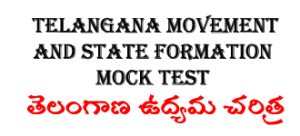
Telangana history from 1948 to 1956 for all competitive exams. Learn Most important questions Telangana Bits For Competitive Exams.
Syllabus:
PAPER-IV TELANGANA MOVEMENT AND STATE FORMATION
I. The idea of Telangana (1948-1970)
1. Historical Background: Telangana as a distinctive cultural unit in Hyderabad Princely State, its
geographical, cultural, socio, political and economic features- people of Telagangana- castes, tribes,
religion, arts, crafts, languages, dialects, fairs, festivals and important places in Telangana.
Administration in Hyderabad Princely State and Administrative Reforms of Salar Jung and Origins
of the issue of Mulkis-Non-Mulkis; Employment and Civil Services Rules under Mir Osman Ali
Khan, VII Nizam’s Farman of 1919 and Definition of Mulki – Establishment of Nizam’s Subjects
League known as the Mulki League 1935 and its Significance; Merger of Hyderabad State into
Indian Union in 1948- Employment policies under Military Rule and Vellodi,1948-52; Violation of
Mulki-Rules and Its Implications.
3. Hyderabad State in Independent India- Formation of Popular Ministry under Burgula Ramakrishna
Rao and 1952 Mulki-Agitation; Demand for Employment of Local people and City College IncidentIts
importance. Justice Jagan Mohan Reddy Committee Report, 1953 – Initial debates and demand
for Telangana State-Reasons for the Formation of States Reorganization Commission (SRC) under
Fazal Ali in 1953-Main Provisions and Recommendations of SRC-Dr. B. R. Ambedkar’s views on
SRC and smaller states.
3. Formation of Andhra Pradesh, 1956: Gentlemen’s Agreement – its Provisions and Recommendations;
Telangana Regional Committee, Composition, Functions and Perfomance -Violation of SafeguardsMigration
from Coastal Andhra Region and its Consequences-Post-1970 development Scenario in
Telangana-Agriculture, Irrigation, Power, Education, Employment, Medical and Health etc.
4. Violation of Employment and Service Rules: Origins of Telangana Agitation- Protest in Kothagudem
and other places, Fast unto Death by Ravindranath; 1969 Agitation for Separate Telangana. Role of
Intellectuals, Students, Employees in Jai Telangana Movement.
5. Formation of Telangana Praja Samithi and Course of Movement – the Spread of Telangana
Movement- Major Events, Leaders and Personalities- All Party Accord – Go 36 – Suppression of
Telangana Movement and its Consequences-The Eight Point and Five-Point Formulas-Implications.
II. Mobilisational phase (1971 -1990)
1. Court Judgements on Mulki Rules- Jai Andhra Movement and its Consequences- Six Point Formula
1973, and its Provisions; Article 371-D, Presidential Order, 1975-Officers (Jayabharat Reddy)
Committee Report- G.O. 610 (1985); its Provisions and Violation- Reaction and Representations of
Telangana Employees
2. Rise and Spread of Naxalite Movement, causes and consequences – Anti-Landlord Struggles in
Jagityala-Siricilla, North Telangana; Rytu-Cooli Sanghams; Alienation of Tribal Lands and Adivasi
Resistance- Jal, Jungle, and Zamin.
3. Rise of Regional Parties in 1980’s and Changes in the Political, Socio-Economic and Cultural
fabric of Telangana- Notion of Telugu Jathi and suppression of Telangana identity- Expansion of
new economy in Hyderabad and other parts of Telangana; Real Estate, Contracts, Finance Companies;
Film, Media and Entertainment Industry; Corporate Education and Hospitals etc; Dominant Culture
and its implications for Telangana self respect, Dialect, Language and Culture.
4. Liberalization and Privatisation policies in 1990’s and their consequences – Emergence of regional
disparities and imbalances in political power, administration, education, employment- Agrarian
crisis and decline of Handicrafts in Telangana and its impact on Telangana Society and economy.
5. Quest for Telangana identity-intellectual discussions and debates- political and ideological efforts
– Growth of popular unrest against regional disparities, discrimination and under development of
Telangana.
III. Towards Formation of Telangana State (1991-2014)
1. Public awakening and Intellectual reaction against discrimination- formation of Civil society
organisation, Articulation of separate Telanagana Identity; Initial organisations raised the issues of
separate Telangana; Telangana Information Trust – Telangana Aikya Vedika, Bhuvanagiri Sabha –
Telangana Jana Sabha, Telangana Maha Sabha – Warangal Decleration – Telangana Vidyarthula
Vedika; etc., Efforts of Telangana Congress & BJP in highlighting the issue.
2. Establishment of Telangana Rashtra Samithi in 2001, Political Realignment and Electoral Alliances
in 2004 and later Phase of Telangana Movement – TRS in UPA- Girgliani Committee- Telangana
Employees Joint Action Committee – Pranab Mukherjee Committee- 2009-Elections-AlliancesTelangana
in Election Manifestos- The agitation against Hyderabad as Free-zone – and Demand for
separate Statehood- Fast-Unto-Death by K.Chandra Shekar Rao-Formation of Political Joint Action
Committee (2009)
3. Role of Political Parties-TRS, Congress, B.J.P., Left parties, T.D.P., M.I.M and other political parties
such as Telangana Praja Front, Telangana United Front etc., Dalit-Bahujan Sanghams and Grass
roots Movement organisations – Other Joint Action Committees and popular protests- Suicides for
the cause of Telangana.
4. Cultural Revivalism in Telangana, other symbolic expressions in Telangana Movement- Literary
forms- performing arts and other cultural expressions- writers, poets, singers, intellectuals, Artists,
Journalists, Students, Employees, Advocates, Doctors, NRIs, women, Civil society groups, organised
and unorganised sectors, castes, communities and other social groups in transforming the agitation
into a mass movement-Intensification of Movement, Forms of Protest and Major events: Sakalajanula
Samme, Non-Cooperation Movement; Million March, etc.,
5. Parliamentary Process; UPA Government’s stand on Telangana- All-Party Meeting- Anthony
Committee- Statements on Telangana by Central Home Minister – Sri Krishna Committee Report
and its Recommendations, AP Assembly and Parliamentary proceedings on Telangana, Declaration
of Telangana State in Parliament, Andhra Pradesh State Reorganization Act, 2014- Elections and
victory of Telangana Rashtra Samithi and the first Government of Telangana State.